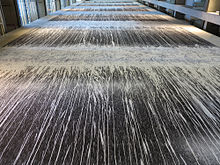Land Art
This is usually documented in artworks using photographs and maps. Land artists would also made land art in the galleries by bringing in material from the landscape and use that to recreate their artwork.
Some land artists include Robert Smithson, Andrew Goldsworthy and Richard Long.
Robert Smithson
Smithson was an American artist, famous for his use of photography for his sculptures and land art. He exhibited in many galleries around the world including the Galleria George Lester in Rome, Italy, the John Weber Gallery in New York.
His early exhibited artworks were collage works influenced by "homoerotic drawings and clippings from beefcake magazines", science fiction, and early Pop Art.
In 1967 Smithson began exploring industrial areas around New Jersey and was fascinated by the sight of dump trucks excavating tons of earth and rock that he described in an essay as the equivalents of the monuments of antiquity. This resulted in the series of 'non-sites' in which earth and rocks collected from a specific area are installed in the gallery as sculptures, often combined with mirrors or glass.

Spiral Jetty 1970

Broken Circle 1971

Amarillo Ramp 1973
Andrew Goldsworthy
Goldsworthy is a British sculptor, photographer and environmentalist producing site-specific sculpture and land art situated in natural and urban settings. The materials used in Andy Goldsworthy's art often include brightly coloured flowers, icicles, leaves, mud, pine cones, snow, stone, twigs, and thorns.
Goldsworthy produced a commissioned work for the entry courtyard of San Francisco's De Young Museum called "Drawn Stone", which echoes San Francisco's frequent earthquakes and their effects. His installation included a giant crack in the pavement that broke off into smaller cracks, and broken limestone, which could be used for benches. The smaller cracks were made with a hammer adding unpredictability to the work as he created it.

Autumn Cherry Leaves

Icicle Star, joined with saliva

Goose Feathers

Rowan Leaves & Hole
Richard Long
Long is an English sculptor and one of the best known British land artists. Several of his works were based around walks that he has made, and as well as land based natural sculpture, he uses the mediums of photography, text and maps of the landscape he has walked over.
In his work, often cited as a response to the environments he walked in, the landscape would be deliberately changed in some way, as in A Line Made by Walking (1967), and sometimes sculptures were made in the landscape from rocks or similar found materials and then photographed. Other pieces consist of photographs or maps of unaltered landscapes accompanied by texts detailing the location and time of the walk it indicates.
His piece Delabole Slate Circle, acquired from the Tate Modern in 1997, is a central piece in Bristol City Museum and Art Gallery.

Delabole Slate Circle

Small White Pebble Circles 1987

South Bank Circle 1991

White Water Falls 2012
Smithson was an American artist, famous for his use of photography for his sculptures and land art. He exhibited in many galleries around the world including the Galleria George Lester in Rome, Italy, the John Weber Gallery in New York.
His early exhibited artworks were collage works influenced by "homoerotic drawings and clippings from beefcake magazines", science fiction, and early Pop Art.
In 1967 Smithson began exploring industrial areas around New Jersey and was fascinated by the sight of dump trucks excavating tons of earth and rock that he described in an essay as the equivalents of the monuments of antiquity. This resulted in the series of 'non-sites' in which earth and rocks collected from a specific area are installed in the gallery as sculptures, often combined with mirrors or glass.
Spiral Jetty 1970
Broken Circle 1971
Amarillo Ramp 1973
Andrew Goldsworthy
Goldsworthy is a British sculptor, photographer and environmentalist producing site-specific sculpture and land art situated in natural and urban settings. The materials used in Andy Goldsworthy's art often include brightly coloured flowers, icicles, leaves, mud, pine cones, snow, stone, twigs, and thorns.
Goldsworthy produced a commissioned work for the entry courtyard of San Francisco's De Young Museum called "Drawn Stone", which echoes San Francisco's frequent earthquakes and their effects. His installation included a giant crack in the pavement that broke off into smaller cracks, and broken limestone, which could be used for benches. The smaller cracks were made with a hammer adding unpredictability to the work as he created it.
Autumn Cherry Leaves
Icicle Star, joined with saliva
Goose Feathers
Rowan Leaves & Hole
Richard Long
Long is an English sculptor and one of the best known British land artists. Several of his works were based around walks that he has made, and as well as land based natural sculpture, he uses the mediums of photography, text and maps of the landscape he has walked over.
In his work, often cited as a response to the environments he walked in, the landscape would be deliberately changed in some way, as in A Line Made by Walking (1967), and sometimes sculptures were made in the landscape from rocks or similar found materials and then photographed. Other pieces consist of photographs or maps of unaltered landscapes accompanied by texts detailing the location and time of the walk it indicates.
His piece Delabole Slate Circle, acquired from the Tate Modern in 1997, is a central piece in Bristol City Museum and Art Gallery.
Delabole Slate Circle

Small White Pebble Circles 1987

South Bank Circle 1991

White Water Falls 2012
No comments:
Post a Comment